Abstract
The life situations of 25 patients with hypogammaglobulinaemia were studied before and after the initiation of subcutaneous replacement therapy by using medical records, data registers and questionnaires (a study and a disease-specific questionnaire, the Sickness Impact Profile and the General Health Rating Index). Before treatment, the patients perceived more dysfunctions with regard to ambulation, mobility, emotional behaviour, social interaction, sleep and rest, household management, work and recreation or pastime activities compared with a Swedish reference group (P = 0.0001). A significant increase in the perceived frequency of infections was also seen in untreated patients compared with a group of healthy individuals (P = 0.0001). After 18 months of weekly subcutaneous infusions of an intramuscular gammaglobulin preparation (100 mg/kg), the patients reported a significantly increased, health-related function and improved self-rated health. A significantly higher pre-infusion IgG level was also found.
Full text
PDF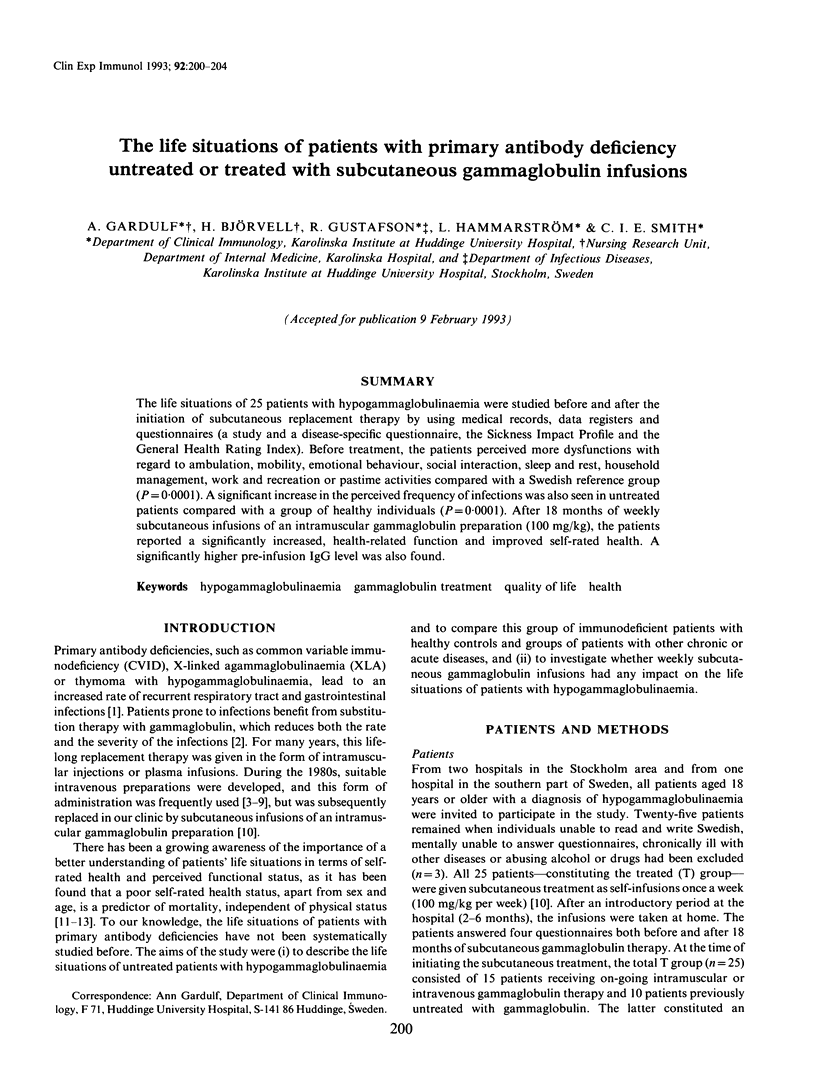
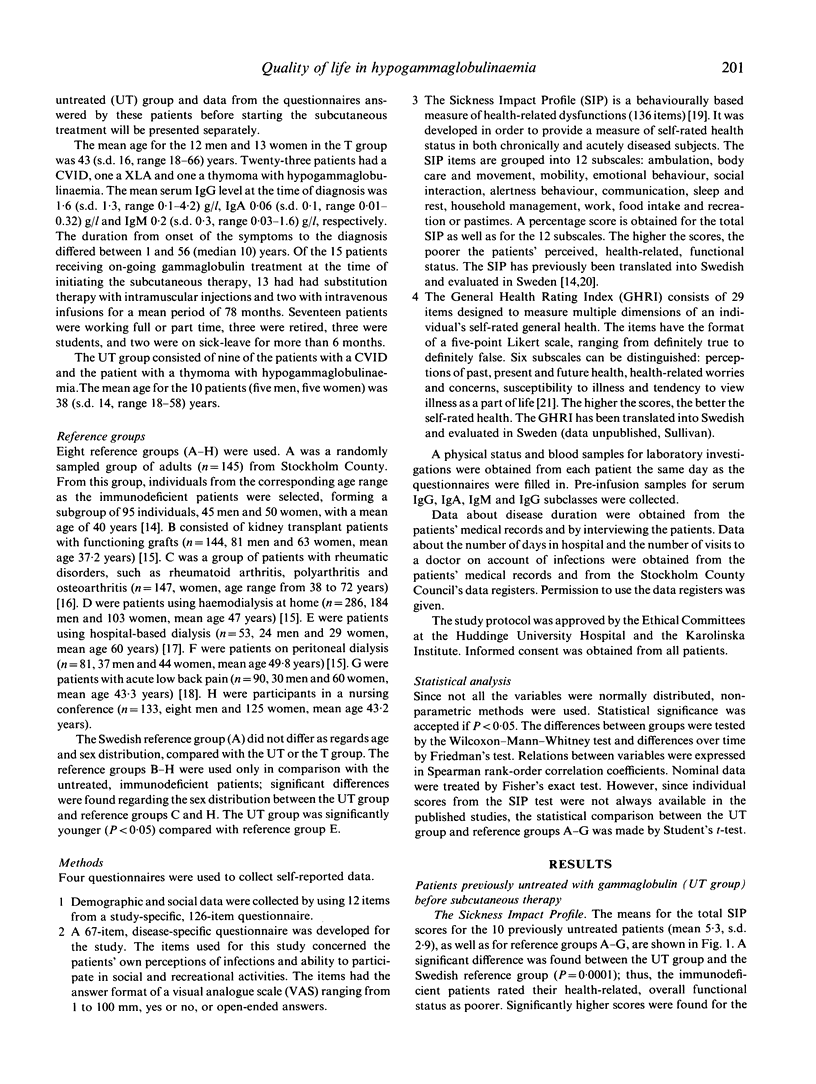
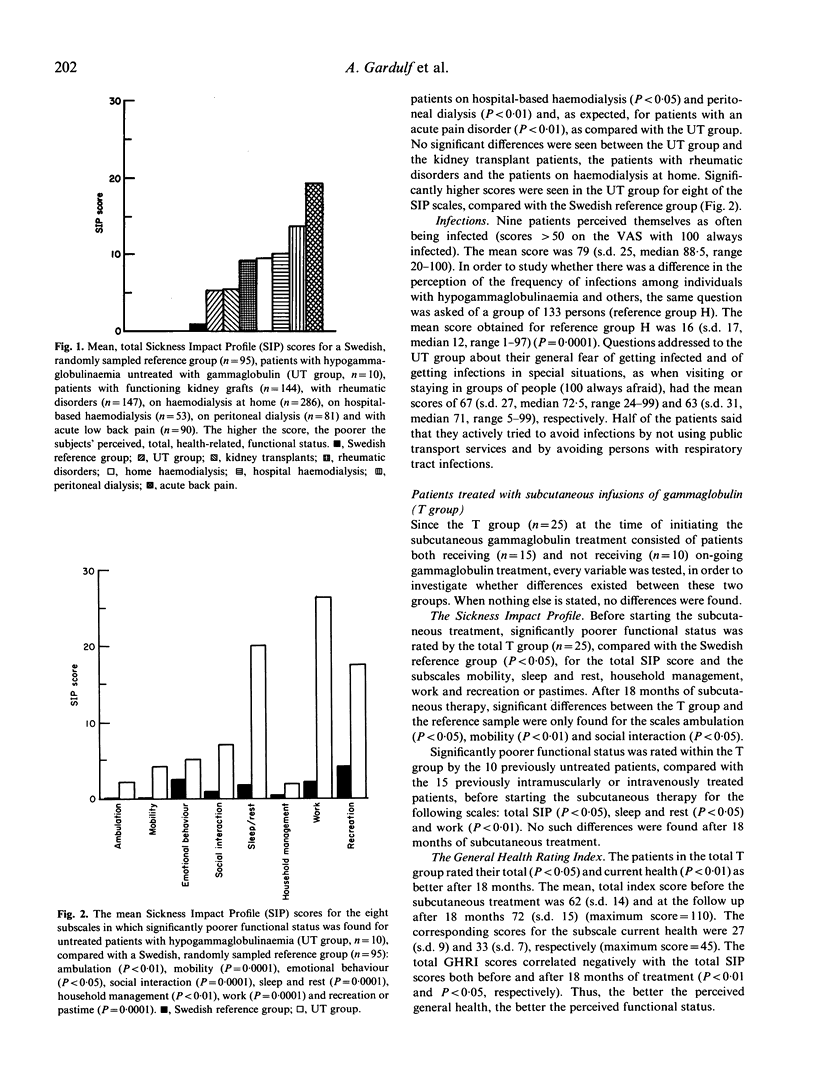
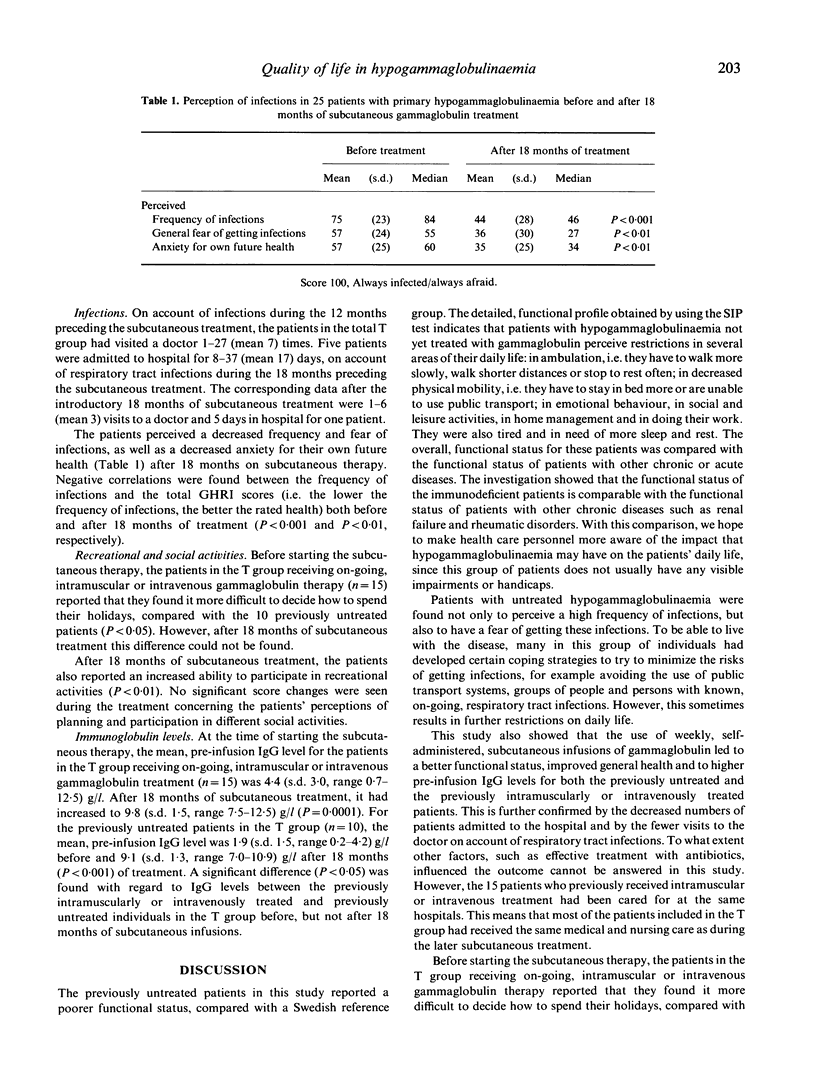
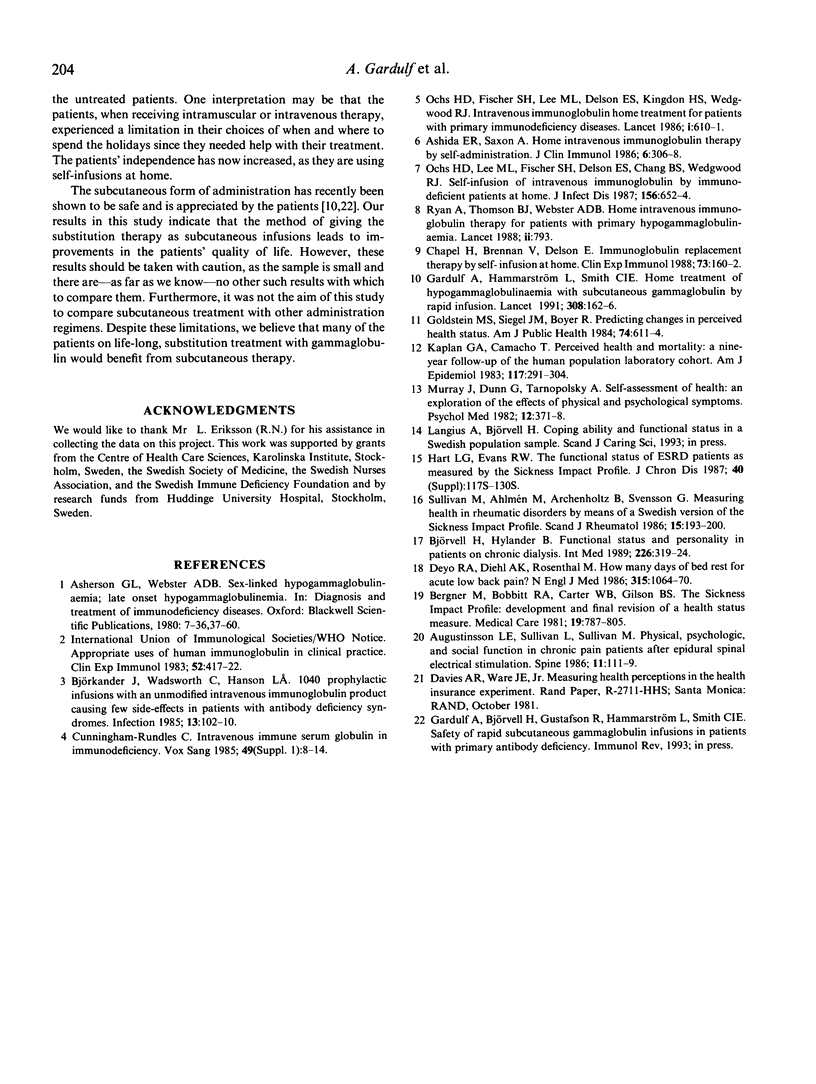
Selected References
These references are in PubMed. This may not be the complete list of references from this article.
- Ashida E. R., Saxon A. Home intravenous immunoglobulin therapy by self-administration. J Clin Immunol. 1986 Jul;6(4):306–309. doi: 10.1007/BF00917331. [DOI] [PubMed] [Google Scholar]
- Augustinsson L. E., Sullivan L., Sullivan M. Physical, psychologic, and social function in chronic pain patients after epidural spinal electrical stimulation. Spine (Phila Pa 1976) 1986 Mar;11(2):111–119. doi: 10.1097/00007632-198603000-00002. [DOI] [PubMed] [Google Scholar]
- Bergner M., Bobbitt R. A., Carter W. B., Gilson B. S. The Sickness Impact Profile: development and final revision of a health status measure. Med Care. 1981 Aug;19(8):787–805. doi: 10.1097/00005650-198108000-00001. [DOI] [PubMed] [Google Scholar]
- Björkander J., Wadsworth C., Hanson L. A. 1040 prophylactic infusions with an unmodified intravenous immunoglobulin product causing few side-effects in patients with antibody deficiency syndromes. Infection. 1985 May-Jun;13(3):102–110. doi: 10.1007/BF01642867. [DOI] [PubMed] [Google Scholar]
- Björvell H., Hylander B. Functional status and personality in patients on chronic dialysis. J Intern Med. 1989 Nov;226(5):319–324. doi: 10.1111/j.1365-2796.1989.tb01402.x. [DOI] [PubMed] [Google Scholar]
- Chapel H., Brennan V., Delson E. Immunoglobulin replacement therapy by self-infusion at home. Clin Exp Immunol. 1988 Jul;73(1):160–162. [PMC free article] [PubMed] [Google Scholar]
- Cunningham-Rundles C. Intravenous immune serum globulin in immunodeficiency. Vox Sang. 1985;49 (Suppl 1):8–14. doi: 10.1111/j.1423-0410.1985.tb01138.x. [DOI] [PubMed] [Google Scholar]
- Deyo R. A., Diehl A. K., Rosenthal M. How many days of bed rest for acute low back pain? A randomized clinical trial. N Engl J Med. 1986 Oct 23;315(17):1064–1070. doi: 10.1056/NEJM198610233151705. [DOI] [PubMed] [Google Scholar]
- Gardulf A., Hammarström L., Smith C. I. Home treatment of hypogammaglobulinaemia with subcutaneous gammaglobulin by rapid infusion. Lancet. 1991 Jul 20;338(8760):162–166. doi: 10.1016/0140-6736(91)90147-h. [DOI] [PubMed] [Google Scholar]
- Goldstein M. S., Siegel J. M., Boyer R. Predicting changes in perceived health status. Am J Public Health. 1984 Jun;74(6):611–614. doi: 10.2105/ajph.74.6.611. [DOI] [PMC free article] [PubMed] [Google Scholar]
- Hart L. G., Evans R. W. The functional status of ESRD patients as measured by the Sickness Impact Profile. J Chronic Dis. 1987;40 (Suppl 1):117S–136S. doi: 10.1016/s0021-9681(87)80041-3. [DOI] [PubMed] [Google Scholar]
- Kaplan G. A., Camacho T. Perceived health and mortality: a nine-year follow-up of the human population laboratory cohort. Am J Epidemiol. 1983 Mar;117(3):292–304. doi: 10.1093/oxfordjournals.aje.a113541. [DOI] [PubMed] [Google Scholar]
- Murray J., Dunn G., Tarnopolsky A. Self-assessment of health: an exploration of the effects of physical and psychological symptoms. Psychol Med. 1982 May;12(2):371–378. doi: 10.1017/s0033291700046705. [DOI] [PubMed] [Google Scholar]
- Ochs H. D., Fischer S. H., Lee M. L., Delson E. S., Kingdon H. S., Wedgwood R. J. Intravenous immunoglobulin home treatment for patients with primary immunodeficiency diseases. Lancet. 1986 Mar 15;1(8481):610–611. doi: 10.1016/s0140-6736(86)92826-6. [DOI] [PubMed] [Google Scholar]
- Ochs H. D., Lee M. L., Fischer S. H., Delson E. S., Chang B. S., Wedgwood R. J. Self-infusion of intravenous immunoglobulin by immunodeficient patients at home. J Infect Dis. 1987 Oct;156(4):652–654. doi: 10.1093/infdis/156.4.652. [DOI] [PubMed] [Google Scholar]
- Ryan A., Thomson B. J., Webster A. D. Home intravenous immunoglobulin therapy for patients with primary hypogammaglobulinaemia. Lancet. 1988 Oct 1;2(8614):793–793. doi: 10.1016/s0140-6736(88)92439-7. [DOI] [PubMed] [Google Scholar]
- Sullivan M., Ahlmén M., Archenholtz B., Svensson G. Measuring health in rheumatic disorders by means of a Swedish version of the sickness impact profile. Results from a population study. Scand J Rheumatol. 1986;15(2):193–200. doi: 10.3109/03009748609102088. [DOI] [PubMed] [Google Scholar]


